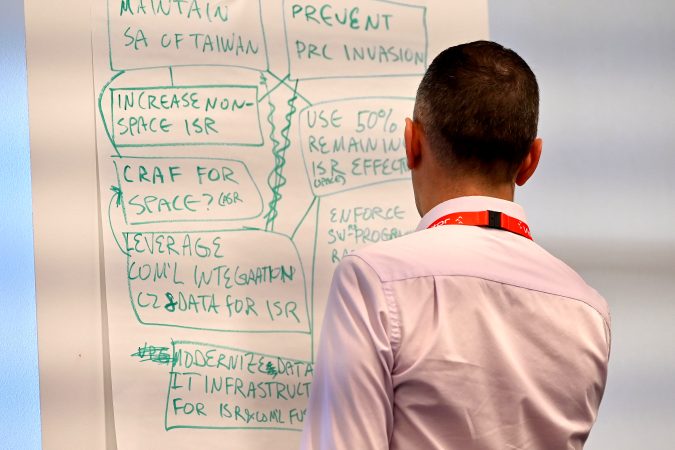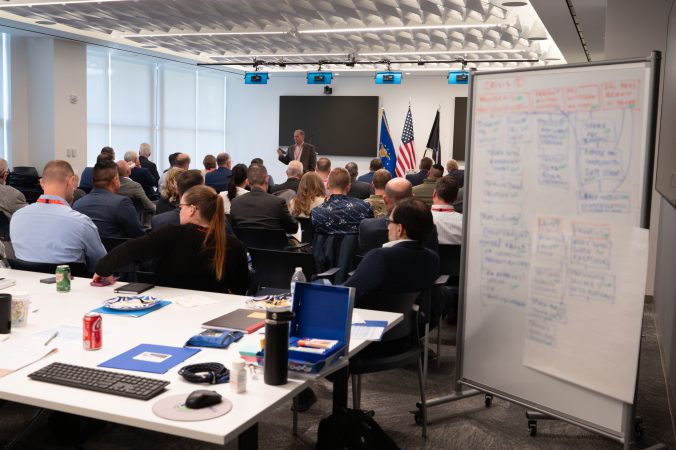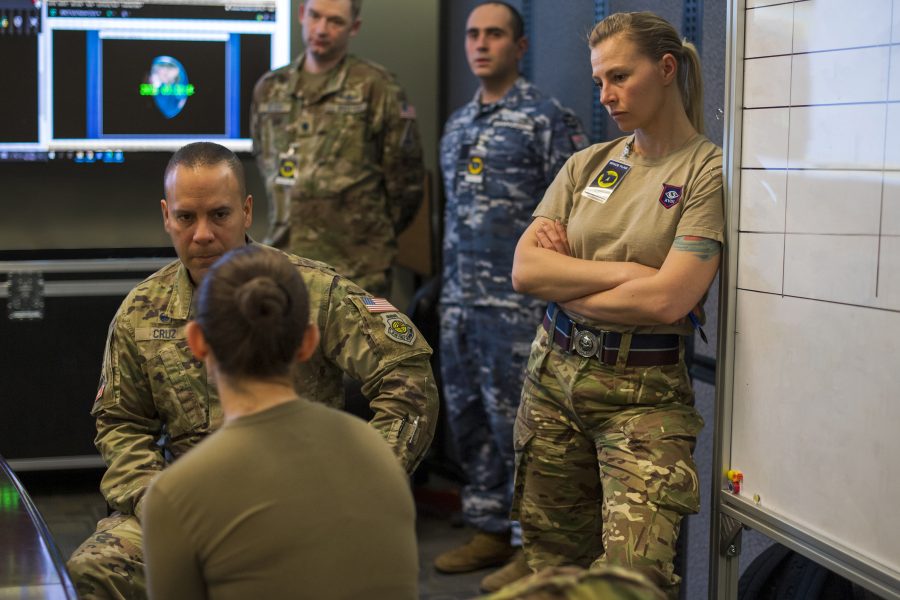A workshop designed to test the Space Force’s theory of “Competitive Endurance” against the likes of Russia and China validated the concept’s core tenets but exposed “unintended consequences” that could harm the service in the long run, said experts from AFA’s Mitchell Institute for Aerospace Studies.
In a new paper by senior resident fellows and retired Cols. Charles Galbreath and Jennifer Reeves, released Feb. 18, the authors acknowledge the limitations of budgets but still question some of the Space Force’s choices in the face of growing threats in orbit and continued skepticism about military space within the Pentagon and the public at large.
“By focusing on solely surviving the competition instead of winning [and] putting the sanctity of the domain above all other objectives—despite our adversaries absolutely not doing the same—we are eroding the warfighting mindset that is necessary for a military service,” Reeves said.
Chief of Space Operations Gen. B. Chance Saltzman first unveiled his “Competitive Endurance” theory in March 2023, offering it as a framework for how the service can protect U.S. interests in space while managing growing competition with other great powers. But he noted then that the theory was intended not as an answer, but as “a starting point for a dialogue I believe is critical.”
The Mitchell Institute moved to jump-start that dialogue in October 2024, hosting a workshop for 55 participants from the Space Force, combatant commands, other Pentagon offices, Congress, industry, academia, and more.

Participants were tasked with finding ways to resolve a series of hypothetical crises in space over the next 25 years, from Russia deploying a nuclear anti-satellite weapon in orbit to China requesting help for a lunar rescue mission.
The results validated some existing Space Force efforts, workshop leaders said, such as the push for greater space domain awareness, the need for high-end training, and the desire to cooperate more closely among the U.S. military services and with allies and partners.
“Understanding through domain awareness was absolutely critical to formulating response options, and this required awareness, but it also required awareness that we could share with our allies and partners, as well as with the American people, so they [too could] understood the consequences,” Galbreath said during a rollout event for the paper.
But analysts identified persistent issues with the way participants treated the space domain and the Space Force—issues they say “Competitive Endurance” isn’t helping.
Space Force leaders have not defined how they could “win” a competition or conflict with China, Galbreath noted, citing the Space Force white paper defining the “Competitive Endurance” theory. The theory seems to emphasize avoiding conflict, not creating orbital debris, and thus “surviving” competition, potentially hamstringing the Space Force against unconstrained adversaries.
Given limited resources and long-standing policies to not militarize space, Reeves said the theory is “as good as it can be.” But after analyzing the workshop results, in which participants were not constrained by policy or budget, Galbreath and Reeves concluded that the theory’s focus on preserving the “sanctity of the domain” and its lack of focus on winning risk not using space as a true warfighting domain.
Reeves and Galbreath cited examples in which Guardian participants in the workshop deferred to commercial capabilities or to other services putting personnel in space years in future operations.
“When that question was brought up during the workshop, and Guardians were like, ‘I don’t know if that’s really ours or not,’ then you had a former Marine stand up and said, ‘If there’s soil underneath the feet, that’s going to be a Soldier or it’s going to be a Marine,’” Galbreath said. “Nobody stood up and said, ‘That’s not right. It’s space. We need to have space experts doing that activity.’”
At other times, participants stuck to longstanding policy rather than risk more aggressive actions. “Many of the participants still thought of space as a sanctuary where only strategic actions could take place,” Reeves said. “Many treated it like the old days, where any offensive actions in space must be considered on par with the use of nuclear weapons.”
Failing to normalize space as a warfighting domain, where victory can be achieved by imposing costs on an adversary, could backfire, Galbreath and Reeves warned. The risk is that the public will not understand the need for a Space Force—and fail to invest appropriately.
“We believe that popular support, and by extension, congressional support, will wane for a military service not focused on winning,” Reeves argued. “And this is a cycle. With less national support and will, funding dries up. Questions about the need for a military service exclusively for space become more prevalent, and it ultimately undermines our ability to create that spacepower advantage that underpins all military operations.”
A strategy aimed at “winning,” paired with a bigger budget and policy changes, are crucial to deterring conflict in space, the experts concluded.
Still, Galbreath and Reeves praised the three core tenets of “competitive endurance”—avoid operational surprise, deny first-move advantage, and conduct responsible counter-space campaigning—saying that all six scenarios workshop scenarios validated the need for better domain awareness to avoid operational surprise.
Commanders across the globe universally want more intelligence, surveillance, and reconnaissance, and Saltzman has called for more “actionable” space domain awareness—suggesting space will be no different in that way than the land, air, and sea domains.

Photo by Mike Tsukamoto/Air & Space Forces Magazine
The workshop also validated the need for sharing domain awareness information between allies and partners, a move that would require classification reforms that have been ongoing.
In scenarios where Russia or China deployed new weapons in space, such as a nuclear ASAT or hunter-killer satellites, participants found that proliferating U.S. and allied assets and having the ability to replenish them quickly were critical—essentially denying the first-mover advantage.
When it came to counter-space campaigning, participants found that having kinetic and nonkinetic offensive and defensive options were key to resolving many of the crises—even as longstanding sensitivities about putting weapons in space persisted, said Robert “Otis” Winkler, an executive at Kratos Defense and a workshop participant.
“One of my big takeaways in the group I was leading was this paradigm of space as a sanctuary, and this idea of a peaceful space,” said Winkler, a retired Air Force colonel and former DARPA executive. “Some of them had a hard time contemplating it, moving into a warfighting domain. And so there was a real paradigm shift that I saw as they worked through some of these problems in counter-space campaigning.”
Indeed, concerns about creating orbital debris are an oft-repeated concern when the topic of space weapons comes up. But self-censoring doesn’t help deterrence, said Arnie Streland, an executive with Northrop Grumman who also participated in the workshop. Streland praised space leaders like U.S. Space Command boss Gen. Stephen N. Whiting have gradually become more comfortable speaking up.
“You need to be able to openly say, ‘Here’s our capabilities and limitations to integrate space into the fight,’” Streland said. “[Gen. Whiting] has talked about space fires because that’s a way of integrating with the other services, speaking in terms like the Army uses, direct and indirect fires. Using terms that make sense and make integration sense in a joint fight, those are all essential if space is going to be integrated and effective in future conflicts.”
Concerns about debris in space resulting from military action are not the central concern of the Space Force, but rather are factors that must be taken into account by political leaders and policymakers, not the military.
“We need to be able to provide a range of options to our decision-makers, and some of those might include the potential creation of debris,” Galbreath said. “They need to understand that that is an option, these are the consequences of taking that action. But if we only have do nothing or create debris, we’re not giving our leaders a good enough set of options to choose from.”
